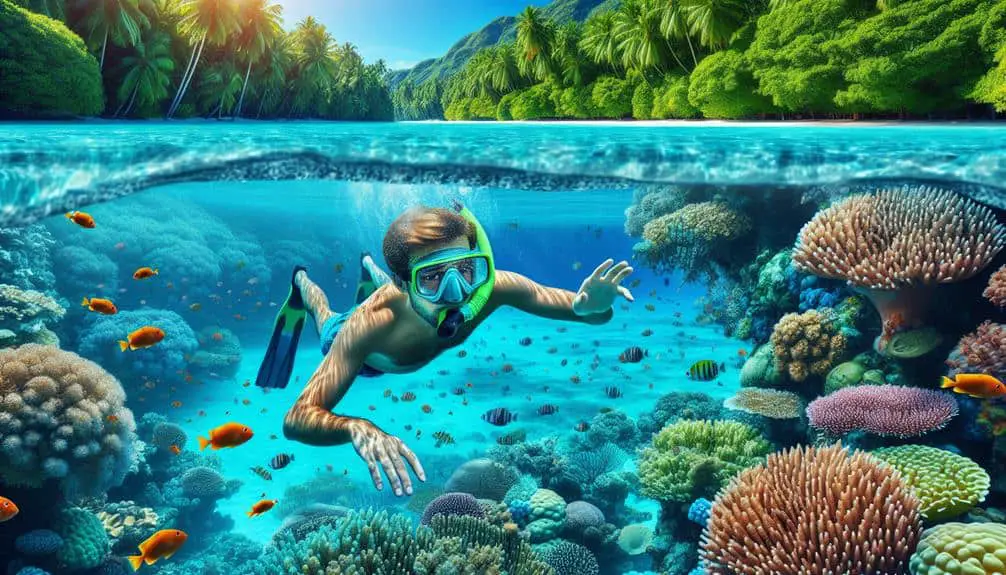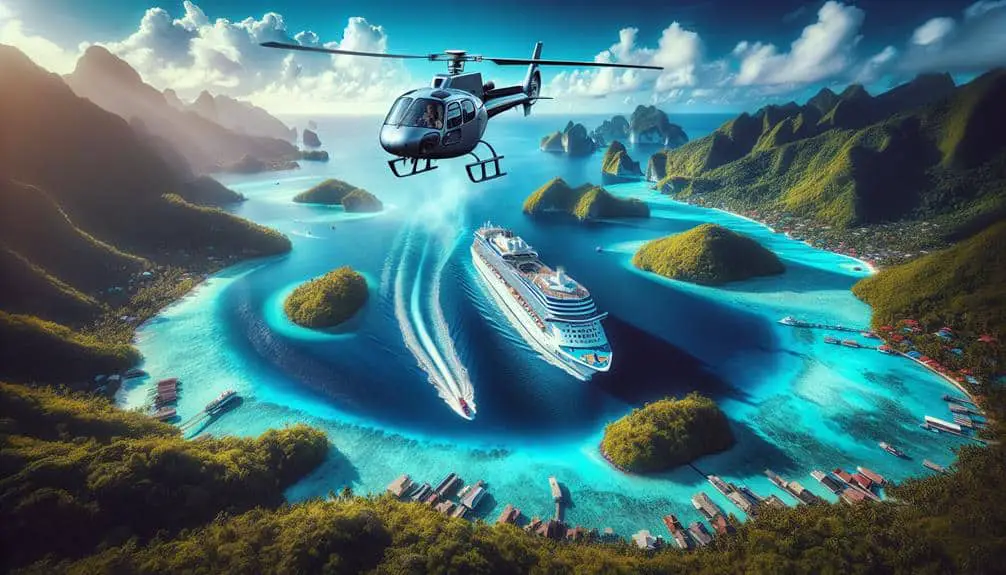Prepare for an unforgettable Caribbean snorkeling adventure by choosing the right excursion operator. Prioritize safety, examine reviews, and respect marine life. Pack essential gear like a snug mask, wetsuit, and snorkeling vest. Ideal times and locations include early mornings, Cayman Islands, Bonaire, and Turks and Caicos. Follow safety guidelines, emphasize gear maintenance, and practice proper breathing techniques underwater. Capture memories with a waterproof camera, and edit for quality. Choose spots wisely, focus on diverse marine life, and practice eco-friendly snorkeling. Elevate your experience with these tips for a safe and enjoyable exploration into the stunning Caribbean marine world.
Key Points
- Research top Caribbean snorkeling destinations for diverse marine life.
- Choose reputable excursion operators with a focus on safety and conservation.
- Pack essential snorkeling gear like masks, snorkels, wetsuits, and vests.
- Follow safety guidelines, respect marine life, and practice proper snorkeling etiquette.
- Opt for eco-friendly practices to protect coral reefs and marine ecosystems.
Choosing the Right Excursion Operator
When selecting a snorkeling excursion operator in the Caribbean, thoroughly examine their safety record and customer reviews to guarantee a reliable and enjoyable experience. Excursion duration is an important aspect to ponder. Operators differ in the length of their trips, with some offering half-day excursions while others provide full-day adventures. Understanding the duration of the excursion will help you plan your day effectively and make sure you get the most out of your experience.
Another vital factor to research is the local wildlife that you may encounter during your snorkeling trip. The Caribbean is home to a diverse range of marine life, including colorful fish, coral reefs, turtles, and even the occasional dolphin or manatee. Knowing what to expect regarding local wildlife can enhance your excitement and prepare you for the breathtaking sights you're likely to see underwater. Be sure to choose an operator that prioritizes marine conservation and respects the natural habitat of these incredible creatures for an ethical and unforgettable snorkeling experience.
Packing Essential Snorkeling Gear
Packing the essential snorkeling gear is important for ensuring a safe and enjoyable underwater exploration in the Caribbean. When preparing for your snorkel adventure, consider the snorkel location to determine the gear requirements. For instance, if you plan to explore coral reefs, opt for fins to help you navigate through the water effortlessly.
Proper gear maintenance is essential to ensure the longevity and performance of your equipment. Rinse your snorkel, mask, and fins with fresh water after each use to remove saltwater residue that can deteriorate the materials over time.
Make sure your mask fits snugly on your face to prevent water from seeping in, and test the snorkel's mouthpiece for comfort and proper fit. A well-fitting wetsuit can provide warmth and protection, especially in cooler waters. Additionally, a snorkeling vest can offer buoyancy and safety, particularly for beginners or those less confident in the water.
Optimal Snorkeling Times and Locations
To maximize your Caribbean snorkeling experience, understanding the best times and locations for snorkeling is crucial. The best times for snorkeling in the Caribbean are usually early in the morning or late afternoon when the sun isn't too harsh, and visibility is at its peak.
Popular locations for snorkeling in the Caribbean include the crystal-clear waters of the Cayman Islands, the vibrant coral reefs of Bonaire, and the marine life-rich waters of Turks and Caicos.
In the Cayman Islands, the best times for snorkeling are typically in the morning before the crowds arrive, allowing you to enjoy the beauty of the underwater world in peace. Bonaire is known for its excellent shore snorkeling opportunities, with popular spots like the Bari Reef offering a chance to see an abundance of colorful fish and corals.
Turks and Caicos, on the other hand, boasts some of the best snorkeling sites in the Caribbean, such as Smith's Reef and Coral Gardens, where you can encounter sea turtles, rays, and tropical fish. Choosing the best times and locations for snorkeling in the Caribbean will guarantee a memorable and rewarding underwater adventure.
Safety Precautions and Guidelines
Guarantee your safety during snorkeling excursions by emphasizing the importance of proper safety gear such as masks, snorkels, and fins.
Always follow supervision guidelines and be attentive to the specified areas where snorkeling is allowed.
Monitoring your surroundings and staying conscious of other snorkelers and marine life will contribute to a safe and enjoyable experience.
Safety Gear Importance
Maintaining your safety while snorkeling in the Caribbean waters requires the proper use of essential safety gear. Proper gear maintenance and equipment care are vital for a safe snorkeling experience. Before each snorkeling session, make sure that your mask, snorkel, and fins are in good condition, with no cracks or faults. Check that all straps are secure and functioning correctly.
Additionally, choose gear that fits well to prevent discomfort or accidents while underwater. Assess water visibility and reef conditions before entering the water to anticipate any potential risks. By using well-maintained gear and being aware of the underwater environment, you can enhance your safety and enjoyment during your Caribbean snorkeling excursions.
Supervision and Monitoring
Before embarking on your Caribbean snorkeling adventure, it's vital to establish clear supervision and monitoring protocols to guarantee the safety of all participants. Implementing strong safety protocols and effective communication strategies can greatly enhance the overall experience.
Here are essential tips to ensure a safe snorkeling excursion:
- Establish Clear Buddy System: Pair participants to keep an eye on each other during the outing.
- Regular Headcounts: Conduct frequent headcounts to verify everyone is present and accounted for.
- Designated Safety Briefings: Provide comprehensive safety briefings before entering the water to address potential risks.
- Emergency Response Training: Ensure all participants are familiar with emergency procedures and know how to respond in critical situations.
Enhancing Your Snorkeling Experience
To enhance your snorkeling experience in the Caribbean, consider incorporating proper breathing techniques to optimize your time underwater. Efficient breathing not only prolongs your time beneath the surface but also helps you stay calm and relaxed, allowing you to fully appreciate the underwater wildlife around you. Practice slow, deep breaths through your snorkel, focusing on inhaling and exhaling steadily. Avoid rapid, shallow breathing, as it can lead to hyperventilation and a shortened snorkeling session.
Furthermore, respecting snorkeling etiquette and following marine conservation guidelines will enhance your experience and help preserve the crucial ecosystem. Refrain from touching or disturbing marine life, as this can harm both the creatures and their habitats. Keep a safe distance and observe from afar to minimize your impact. Additionally, avoid standing on or kicking coral reefs, as these structures are essential to the marine environment. By being mindful of your actions and surroundings, you can contribute to the protection of the marine life you came to admire.
Capturing Underwater Memories
When capturing underwater memories, make sure you have the essential photo equipment such as a waterproof camera or housing to safeguard your gear.
Editing and sharing your underwater photos can elevate the quality and allow you to showcase your experiences.
Choose the best spots with clear waters and vibrant marine life to capture stunning underwater images.
Photo Equipment Essentials
Enhance your underwater photography experience by ensuring you have the essential photo equipment before embarking on your Caribbean snorkeling outing. Here are some vital items to contemplate:
- Underwater Camera: Invest in a quality underwater camera with a high resolution for clear, vibrant photos.
- Underwater Housing: Use a reliable underwater housing to safeguard your camera from water damage and pressure.
- Strobe or LED Light: Enhance your underwater photography with additional lighting to illuminate subjects and reduce shadows.
- Macro Lens: Capture intricate details of marine life with a macro lens tailored for underwater photography.
Having these essential photo equipment items will help you capture stunning underwater memories during your Caribbean snorkeling adventure.
Editing and Sharing
Consider utilizing photo editing software to refine and share the enthralling underwater memories captured during your Caribbean snorkeling expedition.
When editing, focus on enhancing colors and clarity, adjusting contrast, and removing any unwanted elements. Popular editing tools like Lightroom or Photoshop can help you bring out the best in your underwater photos.
Pay attention to sharing etiquette by obtaining permission before posting images of other snorkelers or marine life. When sharing your edited photos, consider using platforms like Instagram or Facebook to showcase your adventures.
Be mindful of not over-editing your pictures; aim for a natural look that accurately represents the beauty of the Caribbean waters. Mastering editing techniques will allow you to create stunning visuals that preserve your snorkeling memories.
Choosing the Best Spots
Where are the best spots for capturing underwater memories during your Caribbean snorkeling adventure?
When looking to document your snorkeling experience, it's important to choose the right locations. To maximize your chances of encountering vibrant marine life and capturing stunning photos, consider the following tips:
- Research the Best Reefs: Utilize local knowledge or guidebooks to identify popular snorkeling spots known for their diverse marine ecosystems.
- Check Water Clarity: Opt for locations with clear waters to enhance the visibility of colorful tropical fish and coral reefs.
- Evaluate Snorkeling Equipment: Make sure your gear is in top condition to avoid technical issues that could hinder your ability to capture memorable underwater moments.
- Follow the Fish: Look for areas where tropical fish congregate, increasing your chances of capturing unique and fascinating photos.
Eco-Friendly Snorkeling Practices
To minimize your impact on coral reefs and marine life while snorkeling, adopt eco-friendly practices such as avoiding touching or stepping on coral, using reef-safe sunscreen, and refraining from feeding fish. Marine conservation is essential for the preservation of delicate ecosystems. When snorkeling, remember that coral reefs are living organisms that provide habitat for numerous marine species. Touching or stepping on coral can cause irreversible damage, so maintaining a safe distance is essential for sustainable tourism.
Furthermore, using reef-safe sunscreen is important to protect coral reefs from harmful chemicals. Chemicals in regular sunscreens can bleach and harm coral, contributing to coral reef degradation. Opt for mineral-based or biodegradable sunscreens that are labeled reef-safe to minimize your ecological footprint.
Feeding fish during snorkeling excursions disrupts their natural feeding behaviors and can lead to imbalances in the marine ecosystem. Enjoy observing fish in their natural habitat without interfering with their feeding patterns. By following these eco-friendly snorkeling practices, you can contribute to marine conservation efforts and promote sustainable tourism in the Caribbean.
Frequently Asked Questions
What Types of Marine Life Can Be Commonly Spotted While Snorkeling in the Caribbean?
When snorkeling in the Caribbean, you can commonly spot a variety of marine life such as vibrant coral reef ecosystems teeming with colorful fish, graceful sea turtles gliding through the water, and playful dolphins dancing in the waves.
Are There Any Specific Cultural or Historical Sites to Explore While on a Snorkeling Excursion in the Caribbean?
While on a Caribbean snorkeling excursion, you can explore fascinating cultural sites like ancient shipwrecks and historical landmarks such as colonial forts. These underwater treasures offer a unique blend of marine beauty and rich history.
How Can I Best Prepare for Potential Seasickness While Snorkeling in the Caribbean?
To prepare for potential seasickness while snorkeling in the Caribbean, consider natural remedies like ginger, medication, or motion sickness bands. Ginger cookies can also help. Stay hydrated, avoid heavy meals, and focus on the horizon.
Are There Any Restrictions or Regulations in Place for Snorkeling in Certain Areas of the Caribbean?
When snorkeling in the Caribbean, regulations play a crucial role in ensuring safety and preserving the marine environment. Restrictions vary by location, with designated protected areas and rules on touching or feeding wildlife. Adhering to these measures promotes sustainable ecotourism.
What Are Some Alternative Activities or Attractions to Consider for a Day When Not Snorkeling in the Caribbean?
When not snorkeling in the Caribbean, explore local cuisine and shopping to immerse in the culture. Engage in hiking for stunning views or try water sports for an adrenaline rush. These activities complement your Caribbean experience beyond snorkeling.




